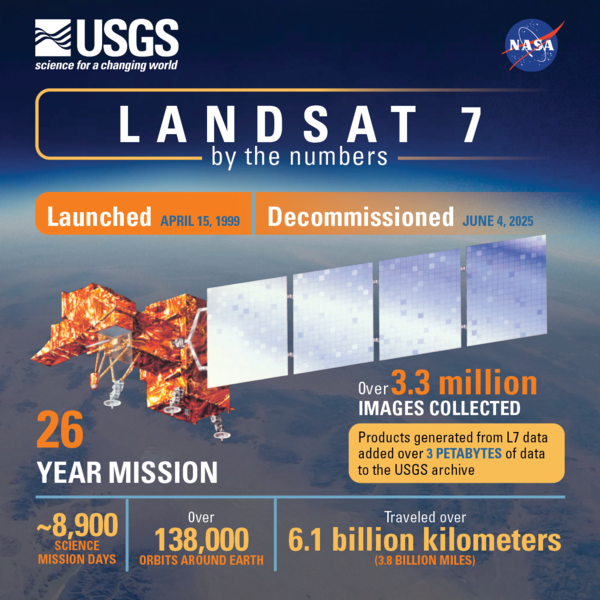A Final Farewell to Landsat 7
Workhorse Earth-observing satellite set to be decommissioned on June 4
The Landsat 7 satellite will receive its final transmission from the U.S. Geological Survey (USGS) on June 4, 2025, at 1:08 PM CST. The satellite launched in April 1999 and will be decommissioned after 26 years in orbit. Its science mission, which focused on collecting imagery data of Earth’s land, inland waters, and coastal waters, spanned 25 years.
However, Landsat 7’s imagery will remain everlasting. The data collected by the satellite's sensor from 1999 to 2024 is a key part of Landsat’s 50-plus year record of imaging our planet’s surface and are preserved in the USGS Earth Resources Observation and Science (EROS) Center archive.
Landsat 7’s active science mission ended in early 2024, with its final images downlinked that May. In total, Landsat 7 spent more than 8,900 days orbiting the Earth and collecting science data.
Data products generated from Landsat 7 account for over 3 petabytes added to the USGS remote sensing archive.
The satellite’s 25 years of continuous science data collection will remain valuable for supporting resource management, scientific discovery and related decision-making for years to come.
Landsat 7’s History & Legacy
Landsat 7, a joint mission of the USGS and NASA, marked a milestone in the Landsat program’s evolution. Launched in 1999, it was the first Landsat to downlink data to the newly established ground station at EROS in Sioux Falls, South Dakota. Its Enhanced Thematic Mapper Plus (ETM+) sensor improved imaging capabilities and expanded the mission’s reach, enabling scientists to observe land change with greater clarity and consistency. Over its lifetime, Landsat 7 became a cornerstone of the USGS/NASA effort to monitor Earth’s land surfaces, surface waters, and coastlines to deliver trusted data to support science and stewardship. Here are some highlights of Landsat 7’s history and achievements:
- Improved instruments: Landsat 7’s ETM+ sensor was designed for routine landscape-scale mapping with 30-meter spectral bands, a 15-meter panchromatic band to provide more precise imagery, and refined thermal data resolution of 60 meters—improved from 120 meters on previous missions.
- Expanded capabilities: Landsat 7 consistently took imagery in regions that previously had limited coverage, enabling projects like the Landsat Image Mosaic of Antarctica (LIMA) and the Millennium Coral Reef Map.
- Historic moments: Smoke rising after the 9/11 attacks, the devastation of Hurricane Katrina, and the spread of the Deepwater Horizon oil spill were among the events captured in Landsat 7 imagery. Beyond the imagery, its consistent data supported emergency response efforts during these and other events.
- Earth As Art: Landsat 7 imagery inspired employees to create collections of stunning shots of Earth that have been admired around the world and are now all available online in the EROS Media Gallery.




Lowering the Orbit
In its final year, the USGS Landsat 7 Flight Operations Team at Goddard Space Flight Center (GSFC) and the ground station crew at EROS closely monitored Landsat 7 while carefully planning for its “passivation”—moving the satellite from an active to a passive state. Once passivated, Landsat 7 will no longer be able to maneuver or send and receive signals from USGS personnel or any other entity.
The first step in this process was to lower the satellite’s orbit, which was completed through two sets of controlled burns on April 8 and April 15, 2025. “With sadness, I am informing you that Landsat 7 has performed its last maneuver and depleted all of its useable fuel. For all planning purposes, Landsat 7 has now become a non-maneuverable satellite,” said Joe Blahovec, USGS Chief of the Satellite & Ground Systems Operations Branch at EROS. He is also responsible for the Landsat Flight Operations Team and Mission Operations Center at GSFC.
Landsat 7 had already been flying in a lower orbit since 2022, when it dropped to an altitude of 697 kilometers (433 miles), making room for Landsat 9 to join Landsat 8 at 705 km (438 miles). Due to increased solar activity in recent years, Landsat 7 had dropped another 5 km to an orbit of about 692 km (430 miles). Following the latest maneuvers, Landsat 7 now orbits at 688 km (427.5 miles), farther away from other satellites in low-Earth orbit and reducing the likelihood of collision concerns.
To further reduce the risk of interfering with future missions, Landsat 7 was shifted from an elliptical to a circular orbit. This adjustment helps minimize the chance of collision with Landsat Next—currently planned to launch in the early 2030s. By the time Landsat Next is operating at a similar altitude, Landsat 7’s circular path will limit how long their orbits overlap, making it less likely that future satellites will need to maneuver around it.
Shutting Down the Satellite
From May 27 through June 4, 2025, mission control has been shutting down systems no longer needed for Landsat 7. Steps include bleeding off the battery charge, disconnecting the battery’s charging circuits, disabling the fuel-line heaters, repositioning the solar array to minimize charging, and turning off the instruments that control the satellite’s “attitude,” or orientation in space.
The final systems to go are those responsible for attitude control. The very last command will shut off the S-band, permanently ending communication between the satellite and the ground.
After that, Landsat 7 will remain silent, drifting in orbit for approximately 55 years before reentering Earth’s atmosphere. Although its mission is over, one final safeguard remains: an internal loop command that manages power, ensuring the satellite remains safely dormant. This system prevents the solar array from generating enough charge to reactivate the satellite, even if it accidentally shifts toward the Sun.
Looking Toward the Future
Landsat 7’s long watch over Earth leaves a legacy that will continue to support science and society for decades to come. Today, Landsat 8 (launched in 2013) and Landsat 9 (launched in 2021) work together to create a complete snapshot of Earth every 8 days. The next generation—Landsat Next—is currently planned to launch in the early 2030s and will offer even greater coverage and detail.
Tim Newman, Program Coordinator for the USGS National Land Imaging Program called Landsat 7 “a transformational bridge between the past and the future of Earth observation.” He added, “Landsat 7 sustained decades of continuity by evolving satellite observations and data products to meet changing priorities and national needs. Its unqualified value to the Nation in science and operational applications helped ensure the future of the long-running Landsat program, inspiring even more capable operational missions like Landsat 8 and 9 and the revolutionary new Landsat Next, now in development. Cheers to all who worked on Landsat 7, and especially the USGS Flight Operations Team for a quarter century of outstanding service to the Nation and the world!”
As the program moves forward, Landsat 7 is remembered fondly by the personnel who spent years commanding the satellite and monitoring its health. They feel a connection to the program’s many accomplishments and future capabilities.
Blahovec reflected: “The Landsat 7 mission stands as a testament to the unwavering dedication and ingenuity of the team that has operated and safeguarded it. Their relentless efforts have enabled the satellite to deliver invaluable Earth observation data to the nation and the global community for over 20 years beyond its original design lifespan. While this moment is bittersweet, the team should take great pride in their remarkable efforts and accomplishments throughout the years.”




